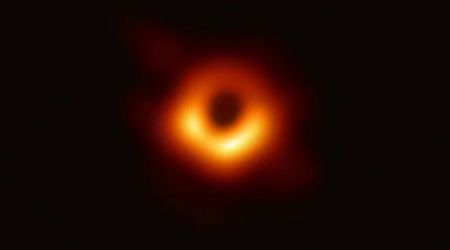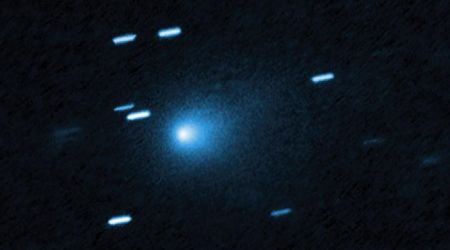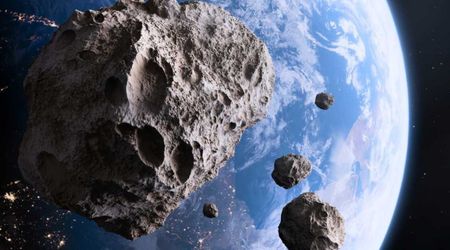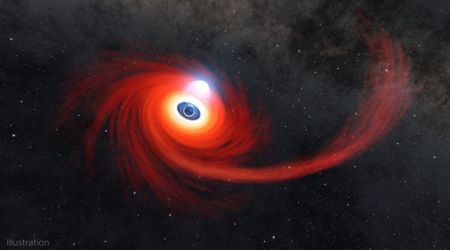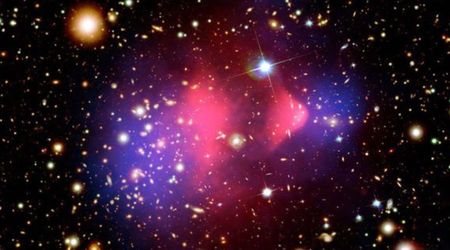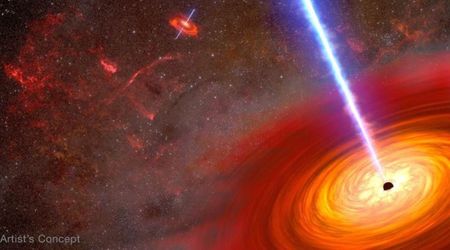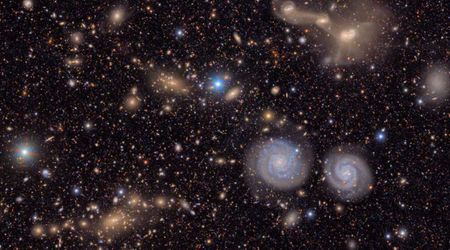what are stars made of?


Stars are the fundamental building blocks of the universe and are responsible for creating most of the elements. Many stars consist of 73% hydrogen, 25% helium and 2% other elements. Stars create the elements. How do they do so and what other elements are stars made of?
How it all began
When the universe was formed during the Big Bang, a hot dense sphere of hydrogen, helium, and trace amounts of lithium and beryllium was formed. This enormous sphere of dust and gas expanded and cooled until the hydrogen and helium atoms began to attract each other gravitationally. Turbulence within the clouds aided in the formation of dense regions and less dense regions. Materials in the centers of the dense regions began to heat up and form protostars. As the collapse continued, these hot dense cores formed stars. The remaining materials either coalesced into planets, asteroids or comets or stayed as regions of gas and dust. The first stars to form after the Big Bang were composed of 73% hydrogen and 25% helium.
As stars age, they undergo nuclear fusion (aka thermonuclear fusion) creating many of the elements that make up our universe. Of the 116 known elements, only 98 occur naturally (atomic numbers 1-98) and 10 of those naturally occurring elements occur in trace amounts. Boron (atomic number 5) to iron (atomic number 26) were formed by fusion in the cores of stars. The remaining naturally occurring elements were formed in nuclear reactions and in supernovas. The other 26 elements are man-made and result from the development of nuclear power plants and particle accelerators.

The different layers of the Sun. Credits: Kelvin Song
How do stars make elements?
Stars change over time and their masses and ages determine how much energy they can produce and how quickly. The Hertzsprung-Russell Diagram (or HR Diagram) describes star classifications and stellar evolution. Stars are composed of many temperatures and pressure layers, which may produce different elements.
Main sequence stars are relatively young stars that contribute ~95% of the stars in the universe. These stars fuse hydrogen into helium and generate great amounts of energy. Main sequence stars age differently according to their size.
Whilst the Sun is indeed very hot, in terms of the rest of the temperatures the photosphere is the coolest part of the star itself, with its highest layers only reaching around 3,700°C (6,700°F).
White dwarfs
When main-sequence stars with masses of ~0.25 Solar masses exhaust their supplies of hydrogen, they collapse into white dwarfs. White dwarfs consist mostly of carbon and oxygen. White dwarfs may accrete hydrogen and helium from the outer layers of other nearby stars. If enough hydrogen and helium build-up, the temperature and pressure of the accreted materials may generate high enough temperatures for thermonuclear fusion. The resulting nova is extremely bright for a short period of time. The cycle of accretion and explosion may repeat or it may result in the complete destruction of the white dwarf.
Red giants
When main-sequence stars with masses from ~0.25-10 Solar masses fuse all of the hydrogens in their cores into helium, their cores begin to collapse. The collapse increases the core’s temperature. Hydrogen outside the core continues to undergo hydrogen fusion, causing the star to expand and cool into a red giant. Inside a red giant, thermonuclear fusion converts hydrogen to helium and helium to carbon.
Supergiants
When main-sequence stars with masses of ~10+ solar masses exhaust their supplies of hydrogen, they begin burning helium. . The pressure of fusion causes them to expand and they evolve into supergiants. These really big stars have the potential to produce heavier elements due to their high temperatures. Supergiants go through a series of nuclear-burning processes depending upon the types of elements burned and produce elements with atomic numbers up to and including iron. Supergiants may fuse hydrogen into helium, helium into carbon, carbon into neon, neon into oxygen, oxygen into silicon and silicon into iron. Nuclear fusion in a star’s core stops once iron is formed.

Supernova
A supernova is the death of a supergiant. Supernova plays a vital role in both producing elements and scattering them across interstellar media. Iron is the most stable atom and iron nuclei absorb energy instead of releasing it. Inside a supergiant, the absorption of energy means there isn’t a release of energy to balance the force of gravity.
Gravity compresses the supergiant’s core. Eventually, the star’s outer layers rebound off the compressed core, and a supernova occurs. An unimaginable amount of energy is released. The resulting temperatures are higher than of any star and result in highly reactive nuclei. Additionally, the destruction of iron nuclei results in a high concentration of neutrons being ejected in the supernova. These two processes produce additional elements with atomic numbers up to Californium (atomic number 98).
These new elements collect in the interstellar medium and may eventually form new stars, planets, comets, or asteroids. Depending upon the size of the collapsed stellar core, the supernova may also produce a neutron star or a black hole.
How do the other elements form
Hydrogen (atomic number 1) to iron (atomic number 26) are the results of thermonuclear fusion. The remaining 2/3 of the elements can be formed when atomic nuclei capture neutrons. The slow process (or s-process) produces elements from cobalt (atomic number 27) to lead (atomic number 82) and bismuth (atomic number 83) and the rapid process (or r-process) produces elements as heavy as fermium (atomic number 100). There is some overlap with the elements produced by the s-process and r-process. The s-process takes place when low-mass stars reach the end of their lives and the r-process takes place when neutron stars merge. Berkelium (atomic number 97) to oganesson (atomic number 118) are man-made.
Conclusion
Stars are the fundamental building blocks of galaxies and their age, distribution and composition trace the history, evolution and dynamics of each galaxy. Stars are mostly hydrogen and helium and are responsible for the manufacture and distribution of heavy elements with different elements being produced by different sized stars. Supernova plays an important role in both creating additional elements and distributing elements throughout the interstellar medium.
